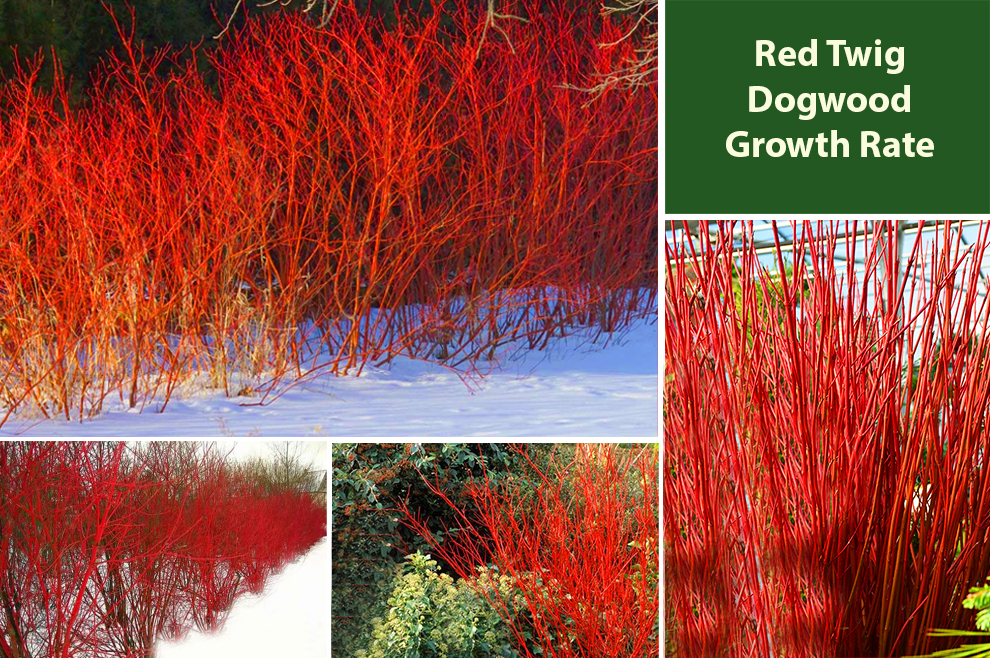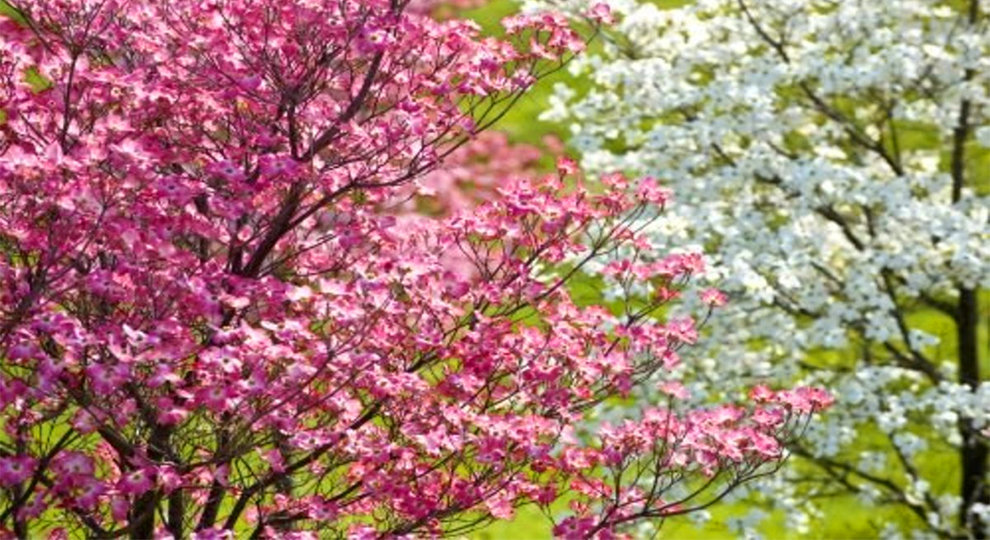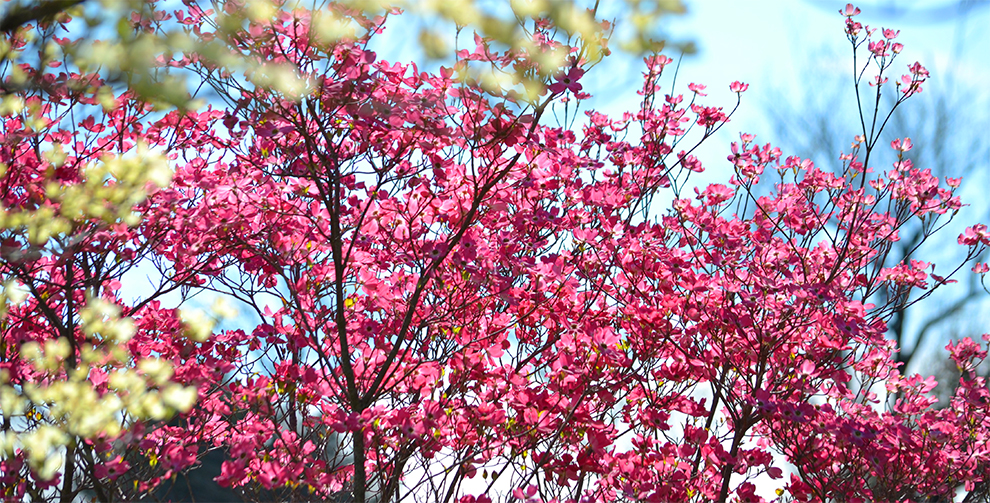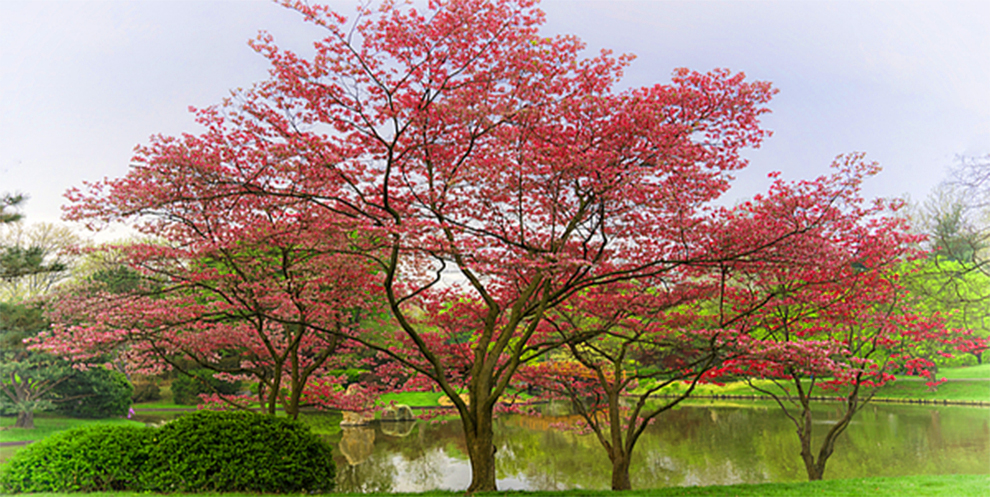How Fast Do Red Twig Dogwoods (Osier) Grow?
Red twig dogwood is truly a delight for your landscape. Experience its stunning growth of up to 2 feet annually with the vibrant red stems.

Red twig dogwoods depict a perfect amalgam of remarkable growth rates and vibrant beauty, leaving an indelible mark on the landscape across the year.
Scientifically called the Cornus sericea, Red twig dogwoods are captivating shrubs renowned for their attractive red stems, which lend a blaze of color to the winter landscapes, instantly capturing the admiration and attention of the onlookers.
Native to the picturesque regions of North America, red twig dogwoods depict an impressive growth rate.
So, how fast do red twig dogwoods grow?
Red twig dogwoods add a minimum of two feet of fresh growth annually. This relentless pace ensures their swift establishment in different landscapes, making them a top choice for borders, hedges, or erosion control along waterways.
Beyond their ornamental appeal, Red Twig Dogwoods are also pretty adaptable. Hence, they can flourish in different soil types. This further amplifies their appeal amongst landscapers and gardeners.
Whether you are a curious enthusiast or a seasoned horticulturist, exploring the fascinating growth habits of these vibrant shrubs promises to be a rewarding journey into the realm of nature’s wonders.
Embrace the allure of red twig dogwoods, and be enchanted by their rapid development and ever-evolving beauty as they flourish and thrive under your care.
Red Twig Dogwood Plant Information and Overview
| Common Name | Red osier dogwood, Tatarian dogwood |
| Scientific name | Cornus servicea, Cornus alba, or Cornus sanguinea |
| Growth rate | 2 feet per year |
| Mature size | 6–9 ft. tall, 8–12 ft. wide |
| Lifespan | 20- to 30-year |
| Growing conditions | Full, partial sunlight with regular watering and moist and acidic soil |
| Blooming season | Spring |
| Hardiness | 3 through 8 USDA |
How Much Is The Growth Rate Of Red Twig Dogwood?
The Red Twig Dogwood (Cornus sericea) growth rate is pretty impressive. They grow at least two feet every year. But please know this growth rate depends on multiple factors, and individual plants may depict different rates.
Some factors that influence the red twig dogwood’s growth rate are as follows:
1. Soil quality: The soil type and fertility significantly influence the growth rate of any plant. Hence red dogwood is no exception. Loamy, rich soil offers vital nutrients, promoting faster and healthier growth of red dogwoods.
2. Environmental conditions: Adequate water, soil, and temperature play a crucial role in determining the growth rate. Dogwoods do best in well-draining soil in partial to full sun.
3. Pruning: Apt and regular pruning can stimulate new growth and boost plant’s overall health. You must prune the plants in the dormant season to foster vigorous growth in the following year.
4. Planting location: Proper placement is crucial for growth. So, plant the red twig dogwoods in areas that receive good air circulation and are guarded against extreme weather conditions.
5. Fertilizing: Offering apt feeding also boosts growth, but excessive fertilization can result in weak stems and imbalanced growth.
By carefully accounting for these factors and offering the dogwood’s best growth conditions, gardeners can ensure their red twig dogwoods flourish and showcase maximum growth potential.
Related: Kousa Dogwood Growth Rate | How Fast Do Pink Dogwood Trees Grow | White Dogwood Growth Rate
How Big Does Red Twig Dogwood Get?
The Cornus sericea, or the Red twig dogwood, reaches 6 to 9 feet (1.8 to 2.7 meters). However, they have a smaller spread. However, it can also grow up to 12 feet (3.7 meters), provided they receive favorable conditions.
Being a deciduous shrub, Red Twig Dogwood does not reach the size of a tree but continues to be an attractive and bushy addition to gardens and landscapes.
Tips For Encouraging Faster Growth Of Red Twig Dogwood
You know the red twig dogwood growth rate, but there are some crucial tips you must follow that help encourage a faster growth rate. These are as follows:
1. Soil preparation: Prior to planting, make sure the soil is well-draining, fertile, and abundant in organic matter to provide essential nutrients for quick growth.
2. Sunlight: Grow your red twig dogwood in a location with access to full to partial sunlight, as adequate light is crucial to promote healthy growth.
3. Watering: Ensure the plants receive regular watering, particularly during dry spells or the initial establishment period, to maintain consistent soil moisture.
4. Feeding: Opt for a slow-release, balanced plant food during the growing season to offer crucial nutrients and ensure robust growth.
5. Companion planting: You can grow your red twig dogwoods alongside other compatible species to create a conducive environment and encourage biodiversity and growth.
6. Mulching: Apply a thick organic mulch layer around the plants will also help. It ensures that the moisture locks in. In addition, it also suppresses weed growth, and maintains optimmum soil temperature.
7. Protection: Guard the younger plants from extreme weather and harsh winds to avoid damage and encourage vigorous growth.
8. Pruning: Prune the plants during the dormant season to remove weak or dead branches. It stimulates new growth and boosts the overall plant health.
9. Regular inspection: Regularly inspect the plant for signs of nutrient deficiencies, diseases, or pests, and address any issues instantly to ensure uninterrupted growth.
10. Propagate: If you seek more red twig dogwoods, you can propagate them via cuttings during the early spring. It accelerates the process of establishing new plants.
With these tips, you can optimize the red twig dogwoods’ growth and amplify their overall vitality and beauty in the landscape.
Growth Stages of Red Dogwood Trees
Broadly, the red dogwood trees’ growth can be divided into three stages, each depicting distinctive characteristics and requirements. Here we will address these three phases in slight detail:
A. Early Establishment Stage

- In this phase, newly planted red twig dogwoods focus on root development. They also acclimatize to their new environment.
- Adequate care and watering are imperative to ensure the young plant’s survival and healthy root growth.
- Mulching around the tree’s base can help retain moisture and guard against temperature fluctuations.
B. Rapid Growth Stage

- When the red dogwood tree establishes its root system, it enters a period of vigorous growth.
- This tree yields new foliage and stems, contributing to its bushiness and overall height.
- Pruning during this phase can encourage branching, resulting in a more compact but fuller appearance.
C. Mature Stage

- In this stage, the red dogwood reaches its full size and depicts its characteristic vibrant red stems.
- It needs less frequent watering as the root system is well-developed and can access the water from deeper soil layers.
- The tree continues to yield new growth but at a slower pace than the rapid growth phase.
- You can prune regularly to remove weak wood or dead branches and maintain its appealing shape.
Across these three stages, offering proper care, including apt pruning, watering, and feeding, is imperative to ensure the tree’s health and maximize its growth potential.
Is Red Twig Dogwood Invasive?
Despite the fast to moderate red osier dogwood growth rate, they are not considered invasive in most regions. Red twig is native to North America and is well-adapted to the ecosystem where it naturally occurs.
You will commonly spot it in gardens and landscaping for its ornamental appeal, especially its rich foliage and alluring red stems.
However, please note that some varieties, especially the cultivated ones, have different growth characteristics or are better suited to specific regions. You must check with the regional invasive species list or local gardening experts to pick a non-invasive variety ideal for your area.
Comparison With Other Tree Species: Is Red Dogwood A Fast-Growing Tree?
Compared to many other tree species, dogwood trees have slow to moderate growth depending on the variety. Red dogwood (Cornus sericea) can be considered a moderately fast-growing shrub rather than a tree. Of course, it depicts an impressive growth rate for a shrub.
It typically reaches a height of around six to nine feet (1.8 to 2.7 meters) with a similar spread. But, under favorable conditions, it may occasionally grow to 12 feet.
In comparison to true trees, such as pines, maples, or oaks, which can grow to towering heights over time, red dogwoods fall on the lower end of the growth spectrum.
These larger trees often grow several feet or more every year, especially during their early years of rapid growth.
Please note that red dogwoods’ classification as shrubs rather than trees is based on their growth habit and size. They produce multiple stems from the base, giving them a bushy appearance.
Nonetheless, their attractive red stems, vibrant foliage, and adaptability make them highly sought-after ornamental plants for beautifying and landscaping gardens.
How Far Apart Should I Plant Red Twig Dogwood?
Ideally, plant the red twig dogwood at least five to ten feet apart, depending on the variety. Larger varieties, such as Arctic Fire or Cardinal, demand more spacing to accommodate their mature height of six to nine feet.
On the contrary, you can grow smaller varieties like Kelsey Dwarf closer together, approximately three to five feet apart, to achieve a more colorful and denser impact in the garden beds during winter and fall.
The spacing choice allows for an appealing landscape design while depicting the vibrant red stems these shrubs are popular for.
